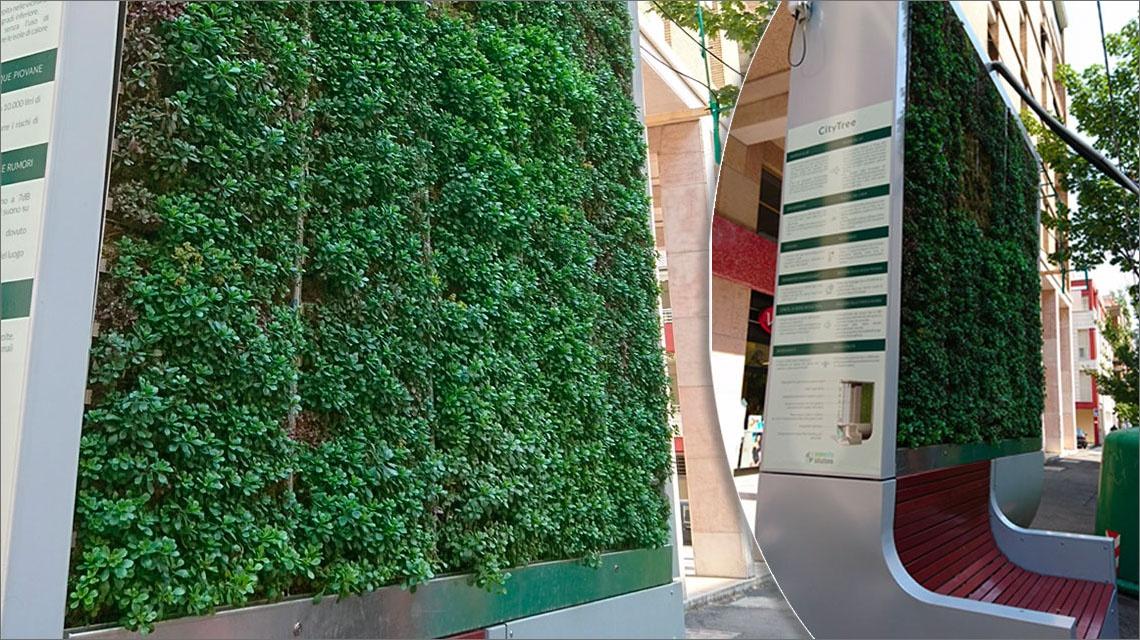Italian National Agency for New Technologies, Energy and Sustainable Economic Development

Environment: ENEA tests urban 'smog-eating' panel 'citytree'
'CityTree' is an innovative mobile plant infrastructure which improves urban air quality thanks to its ability to significantly reduce fine dust concentrations. Conceived as a green urban furnishing solution for streets and squares, schools, shopping centres, companies and airports, the technological device was tested as part of the European project 'CityTree Scaler', which included ENEA, Cnr - Institute of Atmospheric and Climate Sciences (ISAC) and Proambiente Consortium, in collaboration with the German start-up Green City Solutions which produced the panel. The findings were published in the open source online journal Atmosphere.
CityTree can act as an actual vegetable filter with a potential effect equal to 275 trees in a city: it consists of a self-supporting panel 3 meters long, 4 meters high and 60 centimeters deep covered with a variety of moss[1], capable of absorbing up to to 240 tons of CO2 per year. It is an urban furnishing solution designed for those neighborhoods or hot-spot areas without parks, gardens and green areas where air pollution is particularly high. "Its effectiveness is localized in the area near the panel, an area of approximately 200 square meters", pointed out Felicita Russo, researcher at the ENEA Atmospheric Pollution Laboratory.
CityTree uses a fully automated irrigation system, equipped with a rainwater harvesting system and temperature and humidity detectors that ensure maximum crop efficiency and lower water consumption.
To evaluate the effectiveness of this infrastructure, researchers from the Cnr and the Proambiente Consortium conducted measurement campaigns[2] in three different meteorological conditions in Modena, which is located in one of the most polluted areas in Italy, the Po Valley. "Starting from these results, we have reproduced, with modeling tools[3] and thanks to the ENEA CRESCO6 supercomputer, the concentrations of pollutants observed in the field and studied the actual reductions of PM10 and nitrogen oxides (NOx) obtained thanks to CityTree, together with the enlargement of the area affected by the felling. In filtering mode, the device guarantees a reduction of up to 15% of PM10”, pointed out Maria Gabriella Villani, ENEA researcher at the Atmospheric Pollution Laboratory.
The esults were very encouraging for other types of particulate such as PM2.5 (up to -20%), PM1 (up to -13%), ultrafine particles (-38%) and black carbon[4] (-17%), always in the area surrounding the filter panel.
Currently, this green solution can be found in cities such as London and Berlin, where they have been installed both indoors (airports, shopping centers and inside industrial warehouses) and outdoors at the entrance to schools, in city centers and at the headquarters of important companies, to obtain areas of 'fresh and clean air', providing a place for a break, a meeting and information point, an internet access point and an electric recharging station.
“CityTree can also be installed in place of shelters at bus stops or in urban canyons, where city streets are flanked by buildings on both sides, creating poorly ventilated and therefore highly polluted environments. A very localized reduction of pollutants concentration during peak hours could help diminishing the exposure of the population to smog”, pointed out Villani.
“CityTree technologies represent innovative solutions in continuous evolution and working on this area is one of the main purpose of our laboratory. They alone cannot solve urban air pollution, but they nonetheless are smart solutions for improving not only air quality but life quality in general, protecting biodiversity, reducing the effects of heat and renovating the urban fabric with new meeting places”, said Russo.
Photogallery
Note
[1] Lucobryum Glaucum 'Polstermoos' species is placed on the outer surface of the panel due to its strength and ability to resist sunlight, while Amblystagium varium (Plattenmoos) is placed on the inner side because it thrives in less direct sunlight.
[2] https://www.sciencedirect.com/science/article/abs/pii/S1352231021000078
[3] The PMSS (Parallel Micro-SWIFT-Micro SPRAY) modeling system of ARIANET-Suez works with a spatial detail of the order of meters to simulate, at the microscale level, transport and dispersion of pollutants in the atmosphere.
[4] Black carbon (BC) is defined as the set of carbonaceous particles capable of absorbing light with a characteristic wavelength in the visible spectrum (380÷760 nm). It is a primary pollutant emitted during the incomplete combustion of fossil fuels and biomass and can be emitted from natural and anthropic sources in the form of soot (ArpaLombardia https://www.arpalombardia.it/Pages/Aria/Inquinanti/Carbonio.aspx?firstlevel=Inquinanti)
